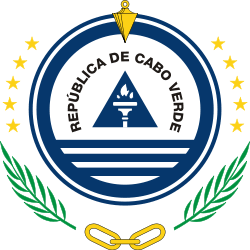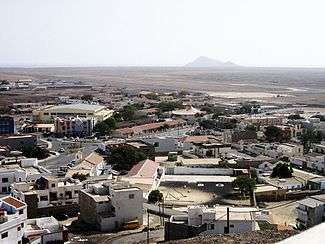Timeline of Sal, Cape Verde
Part of a series on the |
|---|
| History of Cape Verde |
 |
| Colonial history |
| Independence struggle |
|
|
The following is a timeline of the island of Sal, Cape Verde.
Prehistoric era
- 50 million years ago: The island now known as Sal was formed during the eruption of a volcano which is now inactive, the geologically oldest island in Cape Verde.
- Up to about 10,000 years ago: The island was larger and compromised an estimate size of around 1,000 to 1,500 km2 of land, the southern part was underwater at the time.
- Up to about 4,000 BC: The island size was about 300 to 400 km2
Colonial era
See also: Timeline of Portuguese Cape Verde
- 1460 - December 3: The island was discovered, it would be named Llana (Modern Portuguese: Plana) as most of the geography are predominantly of plain.
- 1799 - Salt deposits discovered
- 1800s - The island's first settlement Pedra de Lume established, the island became populated
- 1804 - Cape Verde's first tunnel constructed at Pedra de Lume
- 1830 - Santa Maria founded, became the chief island capital up to the mid 20th century
- 1832 - Estimate population: 400[1]
- 1887 - Salt production went into decline after Brazil nationalized its salt production to Portugal
- 1890 - Population: 539
- 1892 - Farol da Ponta do Sinó near Santa Maria completed
- 1897 - Farol da Ponta Norte constructed, the first tower was completed near Reguinho Fiúra
- 1914 - German salt company no longer mined for salt Production to Germany due to World War I
- 1920 - French salt company Le Salines du Cap-Vert mined for salt production to France
- 1928 - Portuguese salt company mined and shipped it to Belgian Congo (from 1960, Congo-Kinshasa)
- 1930 - Population: 764
- 1935 - Sal became an independent municipality carved out the municipality of Boa Vista or Boa Vista and Sal
- 1937 - SC Santa Maria football (soccer) club established, the first club established on the island
- 1939 - Italian government after granted authorization by the Portuguese government constructed Cape Verde's first major and international airport primarily to serve as a stopover for flights between Rome and South America.
- 1940
- Population: 1,121[2]
- As a consequence of World War II in Europe, the Italians left, airport construction abandoned
- 1941 - Second tower of Farol da Ponta Norte completed, today the lighthouse lay in ruins
- 1945 - May 1: Sport Clube Verdun football (soccer) team established
- 1947 - The Portuguese purchased the airport installations from the Italians, the Portuguese constructed the rest
- 1948 - Banco Nacional Ultramarino opened its branch in the island, it would be replaced with the Bank of Cape Verde in 1975 after the nation became independent
- 1949
- Sal International Airport (now Amílcar Cabral International Airport) opened
- The settlement of Preguiça, named after a settlement in São Nicolau was founded, it is now known as Espargos due to its abundances of asparagus grown in the sandy areas of the area
- 1950
- 1960
- Population: 2,608[2]
- Sal was the stop of a Friendship Flight (Voo da amizade) between Portugal and Brazil, only Brazilian and Portuguese citizens or foreigners with permanent residence in Brazil and Portugal could use those flights, they were popular due to their low fares. Cape Verde was a Portuguese overseas province at the time.
- Around the 1960s - A frigate, likely Danish sunk southeast of Sal and shipped chocolate from the Congo region to Denmark, Ponta and Costa da Fragata would be named after the sunken frigate which is now collapsed into the ocean and is no longer seen. The ship was one of the last European ships sunk in the waters of Cape Verde and within 180 km (100 nm) of the island's shoreline.
- 1961 - When Congo-Kinshasa (now the Democratic Republic of the Congo) declared indepedence from Belgium, Congo nationalized the salt industry and its production, productivity in Santa Maria began to fell
- 1962 - February 26: Juventude (Sal) football (soccer) club established
- 1963 - August 3: Académica do Sal football (soccer) club established
- 1966 - Académico do Aeroporto football (soccer) club established
- 1967 - South African Airways (SAA) used as a refueling stop for flights to and from Europe, since SAA was denied landing rights by most African countries due to the international boycott of apartheid.
- 1970 - Population: 5,505[2]
After independence in 1975-1999
- 1975 - July 5: Cape Verde declared independence from Portugal and became and independent nation
- 1980 - Population: 5,826[2]
- 1982
- April 17: Electricidade e Água do Sal (EAS - Sal Electricity and Water) became part of the national electric company Electra.
- Tropical Storm Beryl struck produced rainfall and gusty winds on the island, early in its duration
- 1983 - SAA used the airport as a refueling sup for its Boeing 747SP service between South Africa and Houston Intercontinental Airport in the US
- 1984 - Salt mining and production ceased in Santa Maria
- 1985 - TACV began services to Boston, Massachusetts, USA using a McDonnell Douglas DC-10 provided by LAM Mozambique Airlines, TACV flights with Boston had now shifted to Praia
- 1990 - Population: 7,715[2]
- 1991 - September 19: GDRC Pretória basketball club established
- Late 1990s - Sal's first seaside touristic village started construction and later completed years later
- March 1994 - When apartheid ended in South Africa, SAA would no longer use Sal as a stopover with flights to and from Europe
- 1999 - End of salt production in Sal
21st century
- 2000
- Population: 14,816[3]
- Sal Island Super Cup established
- 2003 - March 10: Estádio Marcelo Leitão opened
- 2004 - The first hotels and resorts constructed in the southernmost part of the island west of Santa Maria, Funaná and Garupa, owned by RIU.
- 2006 - July 1: SAA operated its final flight to Sal due to the ending of its flights to Atlanta, Georgia in the US
 The south of Espargos and its airport in 2007
The south of Espargos and its airport in 2007 - 2010 - Population: 25,481[3]
- 2014
- Estimate population: 32,000
- April 7:The municipality of Sal started to plan to split into the municipalities of Espargos and Santa Maria due to a massive population growth, Nossa Senhora das Dores will exclude Santa Maria, no date has been set.[4]
- October: Sal Island League introduced the Second Division
- 2015 - Hurricane Fred struck the island on August 31 and lasted until September 1.[5][6]
See also
- Timeline of Boa Vista, Cape Verde
- Timeline of Brava, Cape Verde
- Timeline of Fogo, Cape Verde
- Timeline of Maio, Cape Verde
- Timeline of Santo Antão, Cape Verde
- Timeline of Santiago, Cape Verde
- Timeline of São Nicolau, Cape Verde
- Timeline of São Vicente, Cape Verde
References
- ↑ Roberts, Edmund (1837). Embassy to the Eastern Courts of Cochin-China, Siam, and Muscat. New York: Harper & Brothers. p. 17.
- 1 2 3 4 5 6 Source: Statoids
- 1 2 Source: Instituto Nacional de Estatísticas.
- ↑ "April 7, 2014 Article". A Semana (in Portuguese). Retrieved 16 June 2014.
- ↑ "Resumo a minuto do Furacão Fred". Ocean Press (in Portuguese). 31 August 2015. Retrieved 9 September 2015.
- ↑ "llha do Sal foi uma das mais fustigadas pelo Furacão Fred" (in Portuguese). Macedo de Cavaleiros, Portugal: Radio Onda Livre. 1 September 2015. Retrieved 1 September 2015.
This article is issued from Wikipedia - version of the 12/3/2016. The text is available under the Creative Commons Attribution/Share Alike but additional terms may apply for the media files.